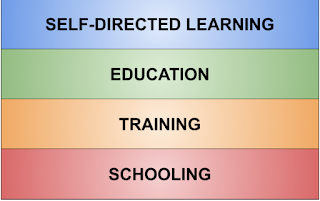Leveling Up Your Learning
Steve Hargadon wrote at the start of this academic year about what he is calling the "Game of School" which is at least partially about the idea that many of us did not see ourselves when we left high school or college as "good learners."
He created what he calls his 4 levels of learning. He's not the first to describe levels of learning. Bloom's Taxonomy may be the most common one but a search will turn up six-level models and five levels and other models. The number isn't so important and certainly, there isn't one answer. What is important is to look at how a model approaches learning.
Hargadon has a four-level model.

The model starts with schooling is where most of us begin our learning. Of course, you learned a lot of things at home and in the world in those pre-school days too, but school is our entry to formal learning.
Hargadon's portray of school is grim: "Schools teach conformance and obedience, getting work done--doing what, when, and how you are told to. Schools are a system of rules, schedules, bells, attendance ratings, and constant testing."
If someones asks you what your education has been, you are most likely to name some schools. Hargadon differentiates this kind of "education" in school from his third level which he calls education.
This schooling level is an industrial model that allows the stratification of the students - some will lead and others will follow. This 19th-century public schooling is a governance strategy and education policy in the United States is largely directed by politicians. Hargadon says that we should note that "a school of fish all turn and swim in a synchronized fashion.. if you get schooled on the basketball court, that means that someone has taught you a lesson, usually in a shaming way."
Level two is training which is learning specific to a career or vocational training. This learning is often self-motivated as a way to move between social and financial classes.
You might guess that level 3, education, might be higher education but in this model that would still be schooling. Rather, this level probably doesn't occur in a school setting but when there are one-to-one relationships and mentors that help a learner move to a higher level and to see something differently than before.
Though this model seems to move in a linear fashion from school (K-20) to training (on the job) to education (work mentors), I would argue that his "education" can occur at any age/stage of life. I would certainly hope that you received some of this level of education when you were in school or in training, though it's not the way those ways of learning are typically structured.
Self-directed learning is level 4 and certainly the goal of the 3 other levels. The goal of a teacher is to get students to a level where they no longer require a teacher and can manage their own learning goals and processes. Intentionally or not, we are all lifelong learners.
This is an interesting model for discussion, but I would say it is already in place. It's an observation of how learning seems to occur ideally. Obviously, things are not ideal at all levels now (in his criticism, "schooling" is the weakest level) but working at all the levels would be a worthwhile path.
Trackbacks
Trackback specific URI for this entryThe author does not allow comments to this entry
Comments
No comments